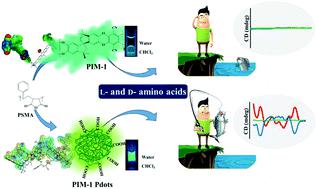当前位置:
X-MOL 学术
›
J. Mater. Chem. C
›
论文详情
Our official English website, www.x-mol.net, welcomes your
feedback! (Note: you will need to create a separate account there.)
Harnessing the enantiomeric recognition ability of hydrophobic polymers of intrinsic microporosity (PIM-1) toward amino acids by converting them into hydrophilic polymer dots
Journal of Materials Chemistry C ( IF 5.7 ) Pub Date : 2020-09-22 , DOI: 10.1039/d0tc03138k Froozan Feizi 1, 2, 3, 4 , Mojtaba Shamsipur 1, 2, 3, 4 , Mohammad Bagher Gholivand 1, 2, 3, 4 , Avat (Arman) Taherpour 1, 2, 3, 4 , Ali Barati 1, 2, 3, 4 , Hosna Shamsipur 4, 5, 6, 7 , Ezeddin Mohajerani 4, 5, 6, 7 , Peter Budd 1, 8, 9, 10
Journal of Materials Chemistry C ( IF 5.7 ) Pub Date : 2020-09-22 , DOI: 10.1039/d0tc03138k Froozan Feizi 1, 2, 3, 4 , Mojtaba Shamsipur 1, 2, 3, 4 , Mohammad Bagher Gholivand 1, 2, 3, 4 , Avat (Arman) Taherpour 1, 2, 3, 4 , Ali Barati 1, 2, 3, 4 , Hosna Shamsipur 4, 5, 6, 7 , Ezeddin Mohajerani 4, 5, 6, 7 , Peter Budd 1, 8, 9, 10
Affiliation

|
In this work, we synthesized novel polymer dots (Pdots) from polymers of intrinsic microporosity (PIM-1) containing a racemic mixture of R- and S-chiral centers as the hydrophobic conjugated polymer chains. Although PIM-1 showed no enantiomeric recognition abilities toward amino acids, we found that this ability can emerge after converting these hydrophobic polymers into nanosized water-soluble Pdots, using poly(styrene-co-maleic anhydride) (PSMA) as a co-polymer that provides carboxyl functional groups on the surface of the Pdots. The stronger interaction of Pdots with amino acids and their higher ability to discriminate the amino acid enantiomers were clearly confirmed by the quantum mechanical calculations, where the difference between the calculated energies for the interaction of D- and L-amino acid enantiomers with the simulated Pdots were remarkably higher than those obtained for the interaction of the enantiomers with just PIM-1. Indeed, the carboxyl surface groups of Pdots played a critical hook-like role in bringing the amino acid enantiomers and chiral centers of the embedded PIM-1 closer together to provide more efficient interactions. The synthesized Pdots were successfully used as highly efficient chiral probes for chiral recognition and determination of the enantiomers of (Phe), tryptophan (Trp), and tyrosine (Tyr) as samples by both fluorescence and circular dichroism spectroscopic methods. The results of this study demonstrated the potential of the suggested method to utilize hydrophobic chiroptical probes in enantiomeric recognition of hydrophilic chiral species.
中文翻译:

通过将内在微孔性(PIM-1)的疏水性聚合物转化为亲水性聚合物点来利用其对映体识别能力
在这项工作中,我们从固有的微孔性(PIM-1)聚合物合成了新型聚合物点(Pdots),该聚合物包含R-和S-手性中心的外消旋混合物作为疏水性共轭聚合物链。虽然PIM-1没有显示出的对映体识别能力朝向氨基酸,我们发现,这种能力可以在这些疏水性聚合物转化成纳米尺寸的水溶性P点,使用聚(苯乙烯-后出现共-马来酸酐)(PSMA)作为在Pdots表面提供羧基官能团的共聚物。量子力学计算清楚地证实了Pdots与氨基酸的较强相互作用以及更高的分辨氨基酸对映体的能力,其中D-和L-氨基酸对映体与模拟Pdots相互作用的计算能之间的差异显着高于对映异构体仅与PIM-1相互作用所获得的那些。实际上,Pdots的羧基表面基团在带入嵌入式PIM-1的氨基酸对映体和手性中心方面起着至关重要的钩状作用相互靠近以提供更有效的交互。合成的Pdots已成功地用作高效手性探针,通过荧光和圆二色光谱方法手性识别和测定了(Phe),色氨酸(Trp)和酪氨酸(Tyr)的对映体。这项研究的结果证明了建议的方法在疏水手性物种的对映体识别中利用疏水手性探针的潜力。
更新日期:2020-10-16
中文翻译:

通过将内在微孔性(PIM-1)的疏水性聚合物转化为亲水性聚合物点来利用其对映体识别能力
在这项工作中,我们从固有的微孔性(PIM-1)聚合物合成了新型聚合物点(Pdots),该聚合物包含R-和S-手性中心的外消旋混合物作为疏水性共轭聚合物链。虽然PIM-1没有显示出的对映体识别能力朝向氨基酸,我们发现,这种能力可以在这些疏水性聚合物转化成纳米尺寸的水溶性P点,使用聚(苯乙烯-后出现共-马来酸酐)(PSMA)作为在Pdots表面提供羧基官能团的共聚物。量子力学计算清楚地证实了Pdots与氨基酸的较强相互作用以及更高的分辨氨基酸对映体的能力,其中D-和L-氨基酸对映体与模拟Pdots相互作用的计算能之间的差异显着高于对映异构体仅与PIM-1相互作用所获得的那些。实际上,Pdots的羧基表面基团在带入嵌入式PIM-1的氨基酸对映体和手性中心方面起着至关重要的钩状作用相互靠近以提供更有效的交互。合成的Pdots已成功地用作高效手性探针,通过荧光和圆二色光谱方法手性识别和测定了(Phe),色氨酸(Trp)和酪氨酸(Tyr)的对映体。这项研究的结果证明了建议的方法在疏水手性物种的对映体识别中利用疏水手性探针的潜力。










































 京公网安备 11010802027423号
京公网安备 11010802027423号